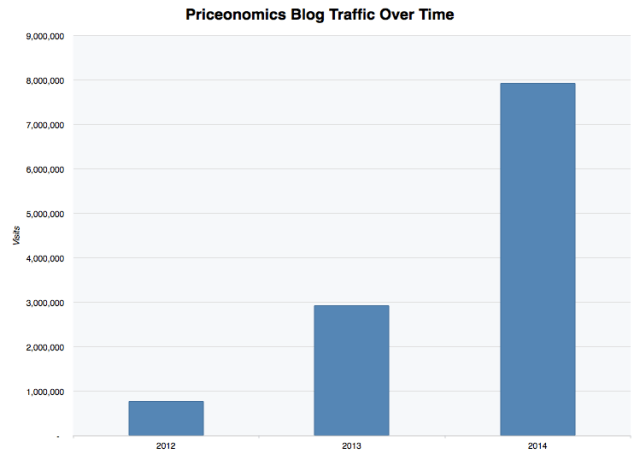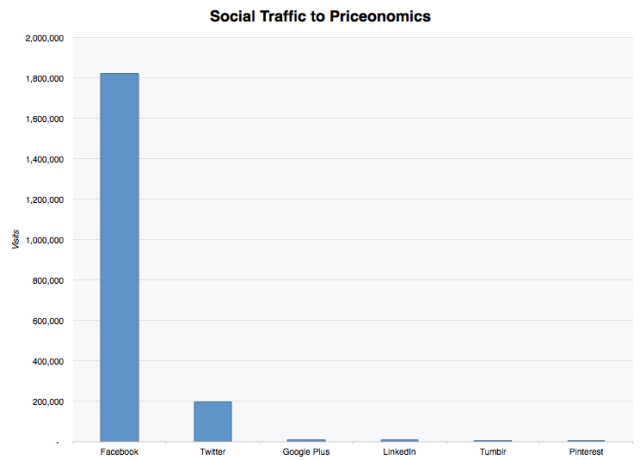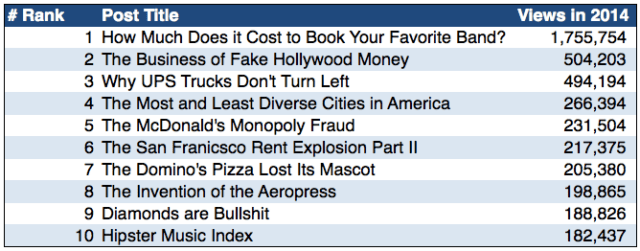
Since 2014 just came to a close, we thought we’d review the sources of traffic to the Priceonomics Blog this year. For the year, the Priceonomics Blog had 7.9 million visitors, about 3x higher than the prior year.
We thought we’d review where our traffic to the blog came from this year in case it provides a small window of what it’s like to be a publisher of content these days. We don’t obsess over the traffic numbers or minutes spent on the site since our revenue, for the time being, is only loosely coupled with these metrics. Instead, we consider traffic to be a vague sign that people like what we’re doing.

Our largest source of traffic, according to our Google Analytics, was “direct” — though, that could mean anything: people sharing over email or chat, or simply direct visits to Priceonomics. Heck, for much of the year, visits from Hacker News showed up as direct too.
Some people call this unattributable referral traffic “dark social.” Many publishers claim to have lots of “direct traffic”, but the reality is that if a third party like Google or Facebook cut off the traffic spigot, “direct traffic” would taper off completely.
After “direct”, Facebook was our largest source of traffic. Across mobile and desktop, the social network sent us 1.8 million visitors this past year. The majority of Facebook traffic was mobile.
You might be surprised to learn that content site Digg was our third largest source of traffic year, surpassing Reddit and Google Search. For those who may not remember, Digg raised tens of millions of dollars, crashed and burned, and then sold to the incubator Betaworks for half a million dollars in 2012. Under Betaworks’ stewardship, editors and algorithms (instead of users) now choose which articles are on the front page. Digg has a clean design, very interesting articles, and appears to be blossoming in its second act.
Traffic from Hacker News, as mentioned earlier, is likely significantly understated since for much of the year it was qualified as “direct” in Google Analytics. Our best guess is it actually sent a similar amount of traffic as Digg.
On the social front, this was, of course, the year of Google Plus. Obviously, we’re kidding. Google Plus sent practically zero traffic to our site this year. Here’s our traffic from sites that could be considered social networks:

In the social category, Twitter has a solid lock on second place, though Facebook referral traffic is 10x that of Twitter. For other sites, Pinterest has emerged as huge source of traffic. Our long form, text-heavy articles aren’t exactly optimized for that medium.
On thing we gradually noticed, however, was that maintaining a Facebook page was pretty much a waste of time by the end of 2014. While Facebook sends lots of traffic to us if one of our articles goes viral, posting said article to the Priceonomics Facebook Page does pretty much nothing any more. Posting on Twitter or emailing things to our readers is much more effective for us than posting on Facebook. We can only imagine how swindled companies that spent millions promoting their Facebook pages must feel. What a monumental waste of money.
Finally, we turn our attention to the hit-driven nature of publishing on the social web. In 2014, we wrote 319 blog posts — a mere 10 of which generated half of our yearly traffic. While we are very proud of some of these articles, frankly, we don’t think this list represents our best work. Our highest-traffic post ever (How Much Does it Cost to Book Your Favorite Band) was something that we sort dashed off and thought it was too unremarkable to even send out over our email subscription list. Nonetheless, it was picked up by hundreds of other publications and websites and shared on Facebook over a hundred forty thousand times.

We generally write posts that aren’t meant to have a shelf life, so they can continue to get traffic even after publication (or even end up in a book). The #9 most popular post of 2014 (Diamonds are Bullshit) was written in 2013, for example. The #5 most popular post (McDonald’s Monopoly Fraud), wasn’t really that popular at publication, but has steadily gotten traffic from Google Search. The #2 most popular post (The Business of Fake Hollywood Money) was pretty popular when we posted it, but exploded when someone posted to Reddit six months later and hit the front page.
Hitting the front page of Reddit is the single highest traffic source we’ve ever seen. The second highest, in our experience, is when lots of people are sharing an article on Facebook. The third highest is being linked to by Daring Fireball.
But in all these cases, the massive traffic influx is just temporary and it completely disappears after a couple of days, leaving you with a bad case of traffic withdrawal. The only thing that seems to reliably increase our audience over time is showing up every day and doing our thing.
This post was written by Rohin Dhar. Follow him on Twitter or Google Plus. To get occasional notifications when we write blog posts, sign up for our email list.



